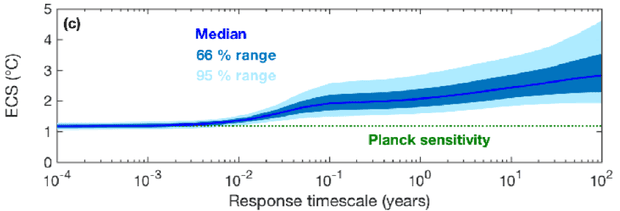
We’re currently on pace to double the carbon dioxide-equivalent (including other greenhouse gases) in the atmosphere by around mid-century. Since the late 1800s scientists have been trying to answer the question, how much global warming will that cause?
In 1979, top climate scientists led by Jule Charney published a reportestimating that if we double the amount of carbon dioxide in the atmosphere from pre-industrial levels of 280 ppm to 560 ppm, temperatures will warm by 3 ± 1.5°C. Four decades later, ‘climate sensitivity’ estimates remain virtually unchanged, but some climate contrarians have argued that the number is at the low end of that range, around 2°C or less.
It’s an important question because if the contrarians are right, the 2°C resulting global warming would represent significantly less severe climate change consequences than if mainstream climate scientists are right and temperatures rise by 3°C. It would also mean our remaining carbon budgetfor meeting the 2°C Paris target is about twice as large than if the mainstream consensus is right. If the consensus is correct, we’re on pace to blow through the remaining Paris carbon budget by around 2030.
Studies published in March 2014, May 2014, and December 2015 identified two critical flaws in the contrarians’ preferred so-called ‘energy balance model’ approach: it doesn’t account for the fact that Earth’s sensitivity can change over time, for example as large ice sheets continue to melt, or that the planet responds differently to different climate ‘forcings’.
Last week, the journal Earth’s Future published a study by the University of Southampton’s Philip Goodwin that took both of these factors into account. Goodwin ran climate model simulations treating every forcing separately, including changes in greenhouse gases, solar activity, particulates from volcanic eruptions, and from human fossil fuel combustion. For each, he included feedbacks from changes in factors like atmospheric water vapor, clouds, snow, and sea ice, including how these factors change over different timescales, as Goodwin explained:
I ran 10 million simulations with a relatively simple climate model. These 10 million simulations each used different climate feedback strengths, and so the way that climate sensitivity responded over time was different in each simulation. To check which of the 10 million simulations were most realistic, I checked each simulation against observations of warming in the atmosphere and ocean up to the present day. I kept only the simulations that agreed with the observations for the real world.
This left 4600 simulations, where the values of the climate sensitivity (and changes in climate sensitivity over different timescales) agree with the atmosphere and ocean warming observed so far. It is from these final 4600 simulations that evaluate how the climate sensitivity evolves over time.
Essentially, adding up all of the warming contributions from all of these factors at any given time tells us how sensitive the climate is on that timescale, whether it be a month, a year, a decade, or a century after atmospheric carbon dioxide levels have doubled.
Over the shortest timeframes of a year or less, Goodwin found that temperatures will rise by about 2°C once carbon dioxide levels have doubled, consistent with the conclusions of the contrarian studies. That makes sense because those studies applied current climate measurements into energy balance models, but since carbon pollution is still rising, the climate still has a large energy imbalance. Climate sensitivity, on the other hand, is usually evaluated at the point when the Earth reaches a new energy equilibrium, long after carbon dioxide levels have stopped rising.
Once our carbon pollution levels decline close to zero (hopefully by mid-to-late century), the planet will start to reach that new equilibrium. The slower feedbacks like melting ice will continue to kick in, and Goodwin found that on timescales close to a century thereafter, temperatures will rise by 1.9–4.6°C, most likely 2.9°C, consistent with mainstream climate science estimates since the 1979 Charney report.

How Earth’s climate sensitivity evolves to a doubling of atmospheric carbon dioxide over different timescales, starting at close to 2°C warming and then rising to about 3°C warming after a decade. Illustration: Goodwin (2018), Earth’s Future
In other words, we are indeed on track to burn through the remaining Paris carbon budget by 2030, and under current international climate policies, we’re most likely headed for about 3.4°C warming by 2100.
Posted by dana1981 on Monday, 24 September, 2018
 |
The Skeptical Science website by Skeptical Science is licensed under a Creative Commons Attribution 3.0 Unported License. |